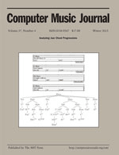
COMPUTER MUSIC JOURNAL
Scope & Guideline
Where Music Meets Cutting-Edge Technology
Introduction
Aims and Scopes
- Human-AI Interaction in Music:
The journal explores the dynamics of human-AI partnerships in music creation, focusing on collaborative processes, co-creativity, and the implications of AI as a musical collaborator. - Computer-Aided Composition and Orchestration:
Research on tools and frameworks that facilitate computer-aided composition, orchestration, and real-time music systems is a core area, emphasizing innovative methods for enhancing musical creativity and expression. - Interactivity and Immersive Experiences:
The journal highlights the development of interactive musical systems, including the use of gestural control and immersive sound environments, promoting new forms of audience engagement and performance. - Sound Analysis and Synthesis Techniques:
A significant focus is placed on advanced sound analysis and synthesis techniques, including granular synthesis, spatial sound synthesis, and novel audio processing methods. - Cultural and Historical Perspectives on Computer Music:
The journal also addresses the cultural and historical contexts of computer music, providing insights into its development and the role of technology in evolving musical practices.
Trending and Emerging
- AI and Machine Learning in Music Creation:
There is a significant increase in research exploring the use of AI and machine learning as tools for music creation, enabling new forms of co-creation and artistic expression between humans and machines. - Real-Time Interaction and Performance Systems:
Recent papers emphasize the development of real-time interaction systems that facilitate live performances, focusing on enhancing the interactivity and responsiveness of both musicians and audiences. - Biosignal and Body-based Interfaces:
Emerging research on using biosignals and body movements as control mechanisms for musical expression is gaining traction, highlighting a trend towards embodied interaction with music technology. - Immersive and Spatial Audio Technologies:
There is a growing interest in immersive audio experiences, with research dedicated to spatial sound synthesis and acoustic localization, reflecting advancements in technology and audience engagement. - Cross-disciplinary Collaboration in Music Technology:
The journal is seeing an increase in interdisciplinary approaches that combine insights from fields such as psychology, computer science, and art, fostering innovative collaborations in music technology.
Declining or Waning
- Traditional Instrumentation in Computer Music:
There appears to be a decline in research focused on traditional instrumentation within the context of computer music, as the field increasingly shifts towards exploring innovative digital instruments and AI-driven compositions. - Static Soundscapes and Sound Design:
Studies that predominantly deal with static soundscapes and conventional sound design techniques are becoming less frequent, as there is a growing interest in dynamic and interactive sound experiences. - Historical Analyses of Computer Music:
While historical perspectives remain valuable, there has been a noticeable decrease in publications solely dedicated to historical analyses, possibly due to the emphasis on contemporary applications and future developments in technology.
Similar Journals
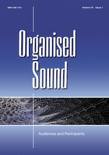
Organised Sound
Fostering Collaboration in the Evolving SoundscapeOrganised Sound, published by Cambridge University Press, stands as a pivotal journal in the fields of Music and Computer Science Applications, reflecting its commitment to advancing interdisciplinary research related to sound and music technologies. Established in 1996, this biannual journal encourages the exploration of new forms of composition, performance, and listening practices using contemporary technological advancements. With an impressive Q1 ranking in Music and a notable place within the top 79th percentile of its category according to Scopus, Organised Sound provides a unique platform for researchers, practitioners, and artists to share innovative ideas and collaborate across disciplines. The journal's rigorous peer-review process ensures high-quality contributions that are informed by the latest theoretical and practical developments. Although currently not an open-access journal, it remains highly regarded for its scholarly depth and relevance in today’s rapidly evolving soundscape.
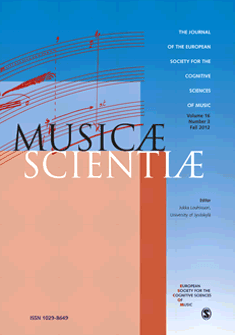
MUSICAE SCIENTIAE
Unveiling the Psychological Dimensions of Musical ExperienceMUSICAE SCIENTIAE, published by SAGE Publications Ltd, is a prestigious interdisciplinary journal situated at the intersection of music and psychological studies. Established in 1997, this journal has garnered an impressive reputation, as evidenced by its 2023 Scopus rankings, where it ranks #2 in Music (Arts and Humanities) and #51 in Experimental and Cognitive Psychology. With a considerable impact factor and categorized in the Q1 and Q2 quartiles, it stands as a key resource for researchers, students, and professionals interested in the cognitive processes related to music engagement and its applications. Although it does not operate under an open access model, MUSICAE SCIENTIAE provides valuable insights and empirical studies that contribute to the ever-evolving understanding of music's impact on human behavior and cognition. By fostering a robust platform for scholarly dialogue, this journal continues to significantly influence research and practice within its fields.
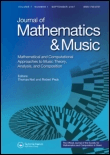
Journal of Mathematics and Music
Exploring the Rhythm of Mathematics.Journal of Mathematics and Music, published by TAYLOR & FRANCIS LTD, serves as a unique interdisciplinary platform that explores the intricate connections between mathematical principles and musical structures. With an ISSN of 1745-9737 and an E-ISSN of 1745-9745, this journal has made significant strides since its inception in 2007, converging its insights through to 2024. Positioned in a competitive landscape with a 2023 ranking of Q1 in Music and Q3 in several mathematics categories, it boasts a commendable Scopus rank of 19/180 in Arts and Humanities - Music. This journal emphasizes the mathematical models that underlie musical compositions and theoretical frameworks, appealing to a diverse audience of researchers, professionals, and students alike. For those interested in strengthening their understanding of the relationship between these two fields without the constraints of open access, the Journal of Mathematics and Music provides a vital resource for fostering innovative thought and collaboration across disciplines. Join leading minds in both music and mathematics as they contribute to this dynamic field of study.
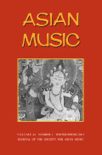
ASIAN MUSIC
Advancing Knowledge in Asian Musicology.ASIAN MUSIC is a distinguished academic journal published by University of Texas Press, focusing on the rich and diverse musical traditions of Asia. With an ISSN of 0044-9202 and an E-ISSN of 1553-5630, this journal serves as a key platform for interdisciplinary research that encompasses musicology, ethnomusicology, and cultural studies related to Asian music practices. While ASIAN MUSIC is not an open-access journal, it provides valuable insights and scholarly articles that contribute significantly to the understanding of music’s role within Asian cultures. The journal originally covered works from 2002 to 2010 and has a reputation for fostering discussions that celebrate the intricacies of sound, performance, and society. Targeting researchers, professionals, and students alike, ASIAN MUSIC stands as a crucial resource for those engaged in the study of music in its multifaceted context.

Music Theory Online
Elevating Musical Scholarship: Engage with Cutting-Edge ResearchMusic Theory Online is a distinguished journal within the field of music, published by the Société for Music Theory. With an ISSN of 1067-3040, this open access journal has been providing valuable insights and scholarly contributions since 1993. Based in the United States, at the University of Chicago, Department of Music, it serves as a platform for rigorous research and discourse in music theory. The journal has achieved significant recognition, attaining a Q1 ranking within its category for 2023 and positioning itself at the 26th percentile among 180 journals in the Arts and Humanities, demonstrating its impact on the field. Facilitating access to cutting-edge studies, Music Theory Online aims to engage researchers, educators, and students by fostering a deeper understanding of music theory concepts and methodologies, thereby contributing to the advancement of musical scholarship.
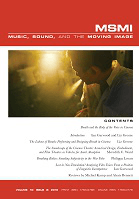
Music Sound and the Moving Image
Connecting the Beats of Sound with the Pulse of ImageMusic Sound and the Moving Image is an esteemed journal published by Liverpool University Press, focusing on the intricate relationships between music, sound, and the moving image. Since its inception, the journal has aimed to foster a multidisciplinary discourse, engaging scholars and practitioners across the fields of musicology, media studies, and visual arts. With an ISSN of 1753-0768 and an E-ISSN of 1753-0776, it has solidified its presence in the academic community, evidenced by its diverse impact reflected in Scopus rankings, including Rank #63/180 in Music and Percentile 65th. The journal's classification in Q3 for Music and its active coverage from 2018 to 2024 enhances its relevance, making it a pivotal resource for researchers and creators who explore the dynamic interplay of sound and imagery. Although currently not available as Open Access, the journal offers a robust platform for peer-reviewed articles, contributing to the advancement of knowledge in this rapidly evolving field.

Problemy Muzykalnoi Nauki-Music Scholarship
Enhancing Understanding of Music's Diverse DimensionsWelcome to Problemy Muzykalnoi Nauki-Music Scholarship, a leading journal in the field of music scholarship published by the esteemed Gnesin Russian Academy of Music. With an ISSN of 2782-358X and an E-ISSN of 2782-3598, this Open Access journal has been committed to the dissemination of high-quality research since 2009, making scholarly work accessible to a global audience. Covering diverse aspects of music theory, history, and its socio-cultural impacts, Problemy Muzykalnoi Nauki serves as an essential platform for scholars, educators, and practitioners in the arts and humanities, as well as in social sciences related to music education. While its Scopus coverage was discontinued in 2021, the journal remains influential, holding a rank of #48 in the Arts and Humanities category and a percentile of 67th, showcasing its relevance and rigor in the discipline. We invite researchers and students alike to explore the rich contributions made within these pages, fostering a deeper understanding and appreciation of music in contemporary society.

MUSIC PERCEPTION
Charting the Terrain of Musical PerceptionMUSIC PERCEPTION is a prestigious academic journal dedicated to the interdisciplinary exploration of musical experience and understanding. Published by the University of California Press, this journal has established itself as an essential resource in the field of music psychology, with a strong emphasis on how auditory stimuli influence human cognition and emotion. The journal boasts a commendable Q1 ranking in Music, placing it within the top-tier of scholarly publications, and it holds an impressive Scopus Rank of #4 out of 180 in the Arts and Humanities category, reflecting its critical role in advancing research within this domain. MUSIC PERCEPTION welcomes contributions that delve into diverse topics, including auditory perception, acoustics, and the psychological impacts of music, making it a vital platform for researchers, professionals, and students seeking to deepen their understanding of music's multifaceted nature. The journal is published annually and remains a cornerstone for academic discourse, ensuring that new findings are readily accessible to a global audience.
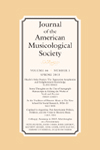
JOURNAL OF THE AMERICAN MUSICOLOGICAL SOCIETY
Pioneering insights in the art of music.JOURNAL OF THE AMERICAN MUSICOLOGICAL SOCIETY, published by University of California Press, is a prestigious peer-reviewed journal dedicated to advancing the field of musicology. With an ISSN of 0003-0139 and E-ISSN 1547-3848, this journal has been a cornerstone of scholarly communication since its inception in 1970 and continues to be relevant through 2024. Its esteemed standing is reflected in its Q2 ranking in the Music category and a respectable 71/180 ranking in the Arts and Humanities discipline, placing it in the 60th percentile among its peers. The journal provides an essential platform for researchers, professionals, and students to explore diverse topics in musicology, ranging from historical studies to contemporary analyses. While it does not currently offer Open Access options, its rigorous editorial standards ensure the publication of high-quality research that contributes significantly to the academic dialogue in music studies. With its address based in the United States at 155 Grand Ave, Suite 400, Oakland, CA 94612-3758, the journal remains a vital resource for those seeking to deepen their understanding of the complexities of music and its societal impacts.

MUSICAL TIMES
Cultivating Scholarly Excellence in MusicologyMUSICAL TIMES is a distinguished journal dedicated to the exploration and dissemination of scholarly works in the realm of music, serving as an essential resource for researchers, professionals, and students alike. Published by MUSICAL TIMES PUBLICATIONS LTD, this journal has built a robust reputation within the arts and humanities, specifically focusing on music studies, with an impactful reach indicated by its Scopus ranking at #73 out of 106 in the field. Though access to this journal is not open, its curated content, which spans various facets of musicology and contemporary music discourse, enriches the academic community by encouraging insightful discussions and critical analyses. With its historical roots tracing back to its inception, MUSICAL TIMES aims to foster a deeper understanding of music's cultural, social, and artistic dimensions, making it a valued publication for those engaged in the scholarly pursuit of music.